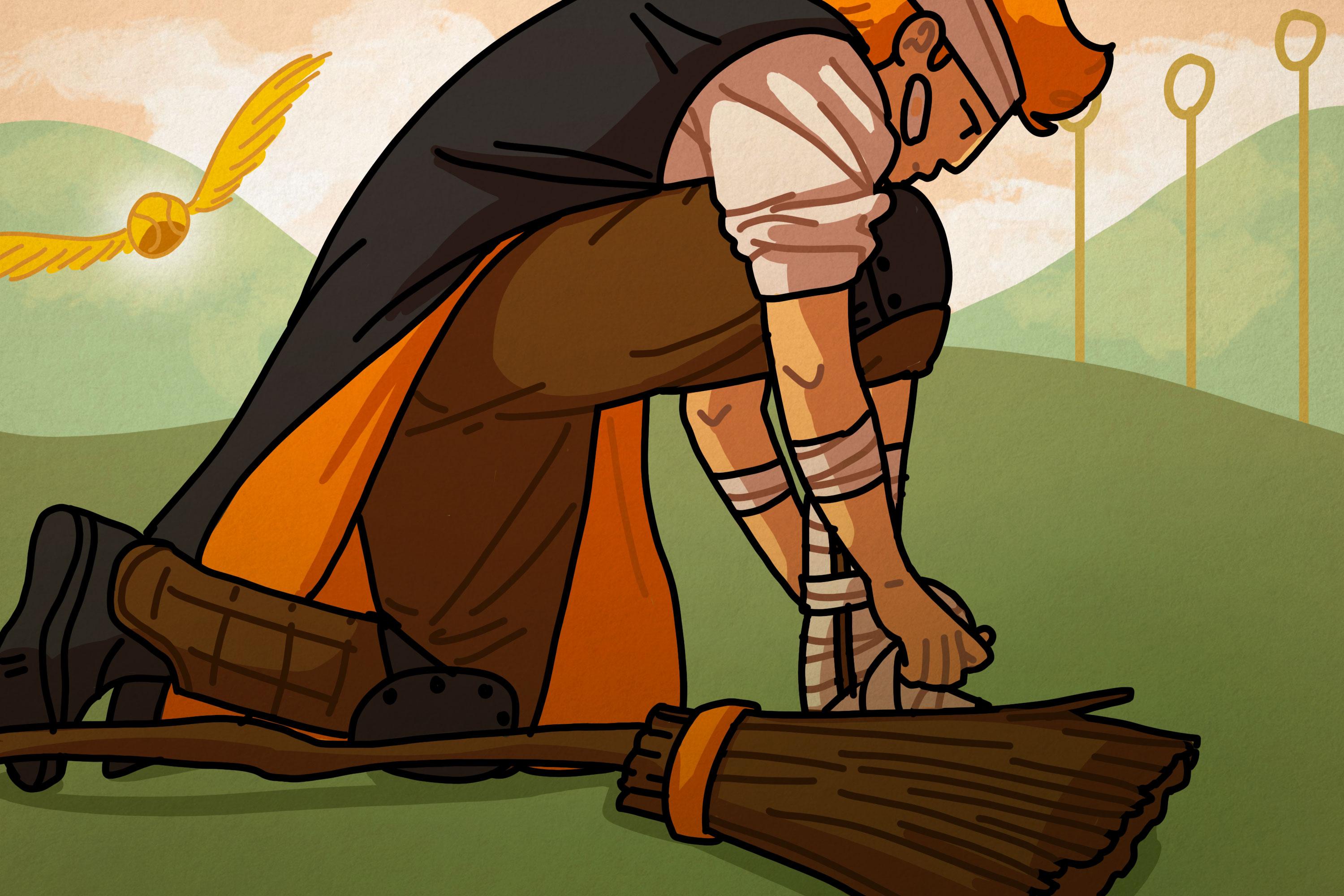
When Blayde Loving heard the crack, he assumed it was just his broomstick.
It was the summer after his freshman year at Arizona State University. That spring, he had joined the Sun Devils Quidditch team, one of many collegiate squads that practice the sport—or at least a version of the sport—dreamed up in J.K. Rowling’s Harry Potter novels. In Rowling’s universe, two teams of wizards compete on magic broomsticks, using a variety of enchanted balls. The muggle variant, which was first codified by a group of freshmen at Middlebury in 2005, lacks Rowling’s spellwork, but maintains its high-octane physicality. There might not be flying, but there’s charging and tackling and strategic beater-hurling galore, a kind of nerd lacrosse crossed with rugby, dodgeball, and childhood fantasies grown up to be strong, fast, and 6 feet tall.
Loving had fallen in love with the sport, and specifically with being a seeker, one of the players deployed midway through the muggle version of the matches in search of the elusive golden snitch—the same position, yes, that Harry Potter plays.
The Sun Devils season had come to a close in April, so on this day, Loving was drafted onto Team Tie-Dye in a mock tournament against players from across the Southwest. As the Tie-Dye seeker, he would wait until the golden snitch—not an autonomous, walnut-sized sphere as in Rowling’s books, but an actual human being dressed all in yellow, with a to-be-captured tennis ball stuffed into a sock and then adhered to his or her rear end—was released. From there, Loving had to capture the snitch-slash-human-tennis-ball before the opposing team’s seeker did the same; a successful catch would score the seeker’s team a commanding 30 points and end the game, meaning the seeker was very often the person to seal the winning lead. “I was not ready for the intensity of the position,” Loving conceded of his then-newly acquired seeker duties. “It was a lot of sprinting and close combat similar to what you see with wrestling.”
But this time, he knew he had it. Loving recognized the snitch—he was a big guy, and fast, with a reputation for evading seekers at close range. Loving sped after him, leaping again and again at his side, only to have the snitch escape his reach. Still: Loving came into the game on a tear, catching winning snitch after winning snitch for Tie-Dye. “I am certain we could have made it to the finals of that tournament if it had not been for my accident,” he said.
And then, well. Loving ran after the snitch one more time, full tilt. “Although in retrospect I don’t know why I kept diving for it,” he said, “this final time I dove for the snitch, making my body completely horizontal to the ground. As I reached for it with my left arm, the snitch tried pushing me to the ground to guard himself, and that’s when the snap was heard.”
That snap, it turns out, was not Loving’s broomstick—it was his collarbone, a fact that was abundantly clear to every person in attendance apart from Loving, who tried to pop back up but found, curiously, that he suddenly couldn’t move his left arm. “Everyone in the front row watching heard and gasped.”
This month, the U.S. national team was crowned the victor of the other World Cup—the 2018 Quidditch World Cup in Florence, Italy, where the U.S. defeated Belgium in the finals to bring home the stars and stripes’ third international Quidditch championship. To answer the immediate questions: Yes, really, with jerseys and everything; between the legs while running; regulation-length PVC pipe or, on occasion, a Swiffer; and entirely on the ground, thank you very much. (Bonus answer: My batting rate for proposed work trips to Tuscany remains, sadly, 0.000.)
The Middlebury students, and the many players who, like Loving, would eventually follow them, had to make some earthbound adaptations to Rowling’s sport: the human golden snitch, for one. But there’s at least one thing that’s true of both the wizard sport and its muggle cousin: Quidditch can really, seriously fuck you up.
Even Potter creator J.K. Rowling has copped to her sport being perhaps a bit more hazardous than your standard muggle parent might prefer. In The Chamber of Secrets, Harry suffers a hideously broken arm after being struck by a rogue bludger, the balls bewitched to knock players off their broomsticks. The attempted repair of that break results in a fortunately non-muggle complication: the disappearance of every bone in Harry’s wounded limb, which necessitates its own painful recovery. Over the next few years, Harry would also experience a bat to the face that resulted in a skull fracture (possible complications in the land o’ muggles: bleeding around the brain, seizure, death), plus a nearly fatal tumble to the ground when soul-sucking dementors got too close to the pitch while he was playing. Other Hogwarts classmates are variously knocked out (Jack Sloper) and left unconscious for a week (Oliver Wood), while professional player (and teenager) Viktor Krum experienced a bloody nose—which, notably, was not called a foul—in The Goblet of Fire’s Quidditch World Cup that left “his red robes shining with blood from his nose.”
“Er—have the bludgers ever killed anyone?” a worried Harry asked in The Sorcerer’s Stone.
“Never at Hogwarts,” Wood, Gryffindor’s team captain, confidently informed the 11-year-old Potter. “We’ve had a couple of broken jaws but nothing worse than that.”
But had Harry asked professor Minerva McGonagall that same question, he might’ve gotten a different answer. Rowling has sketched out the details of McGonagall’s youth on the all-things-Potter hub Pottermore, including the professor’s own, brief Quidditch career. “Minerva was also, like her mother, a gifted Quidditch player,” Rowling wrote, “although a nasty fall in her final year (a foul during the Gryffindor versus Slytherin game which would decide the Cup winner) left her with a concussion, several broken ribs and a lifelong desire to see Slytherin crushed on the Quidditch pitch.”
When Team USA took the field in Florence, a cluster of EMTs stood at the ready by the sideline. This was by design: The International Quidditch Association, the sport’s governing body, requires a team of medics to be on duty for all national and international competitions, with the same precautions strongly recommended for all practice matches. “The IQA takes safety seriously,” Tom Ffiske, the IQA’s head of business development, told me.
2018 marked the fourth-ever Quidditch World Cup, which the IQA hosts in a different global locale every two years; this year 29 nations from five continents competed. The Americans’ triumph over Belgium ended with a decisive 120–70 score, securing the ever-dominant U.S. Quidditch team’s third World Cup trophy and smoothing over some of the pain from the 2016 Cup, when the U.S. took home its lone silver medal after a close loss to Australia. But the team retook gold without its captain, Augustine Monroe: He went down with a shoulder injury in an earlier match against Australia.
Last year, a team of British researchers embarked on the first study of its kind: a quantitative analysis of Quidditch casualties. “As a new sport, we had no data on the safety of the sport and it would have been irresponsible not to look into that,” Ashley Cooper, one of the study’s coauthors as well as a six-year veteran of the game, explained via email. “As a full contact sport, it’s inevitable that at some point there will be a serious injury, and if we hadn’t already been doing this work to prove that mostly Quidditch is safe, and to make it as safe as possible, then it’s likely Quidditch would be shut down.”
The resulting paper, “Injuries in Quidditch: A Descriptive Epidemiological Study,” pooled responses from hundreds of players registered with the British national governing body, Quidditch UK, who were asked for details on any injuries that had required medical attention. The results were a pastiche of thwacks and thumps, torn ACLs, fractures, and one unlucky soul who required a double meniscus repair. But, the study noted, the “injury rates are no higher than those reported in other recreational contact sports.”
“Everyone always asks about injuries caused by the broom,” Cooper said, “and I’ve yet to hear of any injury (beyond a bruise) caused by a broom.”
One finding stood out, however: Women had a higher rate of concussion than men, by a factor of nearly 2-to-1.
Under the rules of the International Quidditch Association, teams may have no more than four players who identify as the same gender in active play on the field at once. The result is that teams are notably diverse along gender lines. Another result: Women tackle, or are tackled by, people who are sometimes quite a bit larger than them.
Cooper cautions that the higher rate of Quidditch concussions for women might not hold up to close inspection. He and his fellow researchers are in the midst of working on a follow-up study to investigate the discrepancy—could it be caused by the size difference between men and women in the sport, or a higher rate of self-reported injuries among women, or something else entirely?—and already, he said, the results “actually appear to show that women don’t have a significantly higher rate of concussion.”
Still, though: There aren’t a lot of games inspired by novels that go on to launch their own medical studies. A cautious throwdown of nerdom this is not.
Jacob Howe has seen his fair share of injuries. He’s seen University of South Florida teammates take knees to the face, including one incident in which a player “basically had the entire left side of his face broken into a million pieces.” “I’ve seen many, many, many collarbones get absolutely annihilated,” he added. USF players have a name for the bad ones: hospital balls, the high-arcing balls that sometimes caught defenseless players behind the hoops. One teammate went for what Howe called a “nasty alley-oop,” only to get undercut. “His foot was basically turned around backwards,” said Howe. “He ended up with a bunch of screws and plates in that ankle and his Quidditch career kinda took a nosedive.” (“Understandably,” he added.)
Then there are all the injuries Howe suffered himself: a broken foot when he landed funny on a hoop a few days before Thanksgiving 2016, a pair of concussions, and a damaged acromioclavicular joint from when he, a little too ambitious after logging three tackles in the space of a single minute, went crashing down on his left shoulder with a chaser in tow on the fourth tackle.
And that’s not counting the regular Quidditch stuff. “I’ve had my guys downstairs speared by opposing brooms. I’ve been poked in the eyes in scrum piles. I’ve been stepped on. I’ve been sucker-punched,” he said. “I’ve been dead-legged while blocking a shot. I’ve gotten bloody noses after getting beat in the face. I’ve had the wind knocked out of me by a big hit.”
Now a senior and with his last Bulls season behind him, Howe is circumspect. “Was it all positive?” he said. “Not all of it.”
Still, though: He’d do it all again. “I would give almost anything to get just one more season with these guys and gals.”
And as for Loving: His collarbone, he was pleased to report, was a clean break. He was sent home in a sling and sentenced to two months of rest, forcing him to miss the better part of an entire season. But now, at last, he’s finally back on the field with the Sun Devils. “I wouldn’t take it back,” he said.

